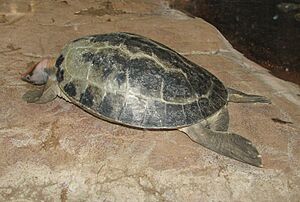Painted terrapin facts for kids
Quick facts for kids Painted terrapin |
|
|---|---|
 |
|
| At Newport Aquarium, Newport, Kentucky | |
| Conservation status | |
| Scientific classification | |
| Genus: |
Batagur
|
| Species: |
borneoensis
|
| Synonyms | |
|
|
The painted terrapin is a special kind of turtle that lives in freshwater. It is also known as the painted batagur or saw-jawed turtle. Its scientific name is Batagur borneoensis. This turtle belongs to the family Geoemydidae. It used to be in its own group, Callagur, but now it's part of the Batagur group.
Where They Live
Painted terrapins live in the warm, wet rainforests of Southeast Asia. You can find them in countries like Brunei, Indonesia (especially on the islands of Sumatra and Kalimantan), Malaysia, and Thailand.
Why They Need Our Help
The painted terrapin is a critically endangered species. This means there are very few of them left in the wild. The IUCN (International Union for Conservation of Nature) has listed them as one of The World's Most 25 Endangered Freshwater Turtles and Tortoises.
They are also protected by CITES (the Convention on International Trade in Endangered Species). This means it is against the rules to trade them for money if they are caught from the wild. This rule was made in Thailand in 2013.
In Indonesia, the government has made the painted terrapin a top animal to protect. In Malaysia, groups like the World Wide Fund for Nature (WWF) help keep these turtles safe.
Dangers They Face
Many things threaten the painted terrapin and make it hard for them to survive:
- Harvesting: Some fishermen catch these turtles to eat them.
- Poaching: People illegally hunt them to sell as pets or for food.
- Habitat Loss: Their homes are being destroyed. Forests are cleared to grow palm oil trees or to create fish and shrimp farms. This takes away the places where they live and lay their eggs.
How We Can Help Them
Many people and groups are working hard to save the painted terrapin:
- Protecting Nests: In Sumatra, Indonesia, people patrol nesting areas. They find and protect the eggs. Once the baby turtles hatch, they are released back into their natural homes. This helps increase the number of turtles in the wild.
- WWF Projects: In Malaysia, the WWF has a special project. It focuses on protecting the painted terrapin and their nesting spots.
- Working Together: This project aims to keep their homes safe. It uses scientific information and works with local communities. The goal is to make sure these efforts can continue for a long time with help from the government and local people.


